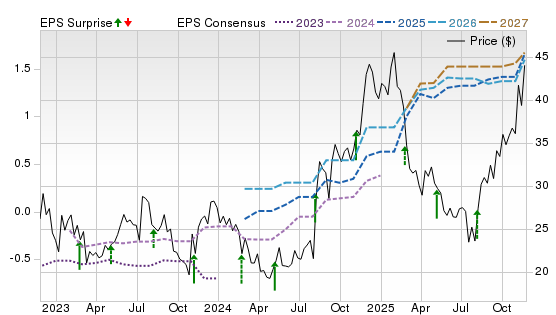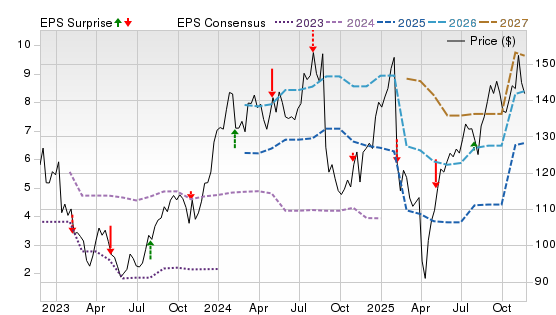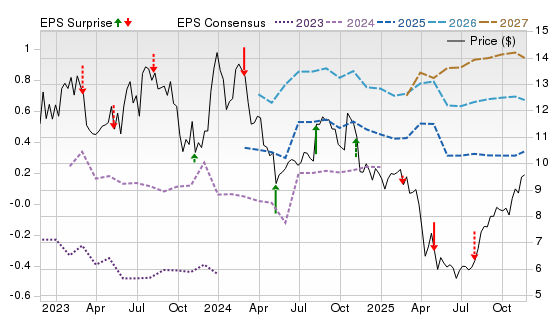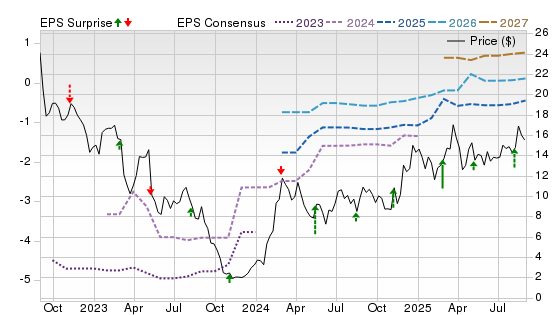5 Top Biotech Stocks to Buy Today
| Company (Ticker) | 12 Week Price Change | Forward PE | Price | Proj EPS Growth (1 Year) | Projected Sales Growth (1Y) |
|---|---|---|---|---|---|
| Veracyte (VCYT) | 26.56% | 26.15 | $42.21 | 38.87% | 14.09% |
| Neurocrine Biosciences (NBIX) | 1.60% | 21.48 | $141.70 | 110.51% | 21.39% |
| Amicus Therapeutics (FOLD) | 33.46% | 30.68 | $11.00 | 47.92% | 19.00% |
| Keros Therapeutics (KROS) | 37.22% | 9.56 | $20.83 | 145.03% | 6,809.40% |
| Arcutis Biotherapeutics (ARQT) | 62.10% | NA | $28.34 | 79.02% | 83.29% |
*Updated on December 17, 2025.
Veracyte (VCYT)
$42.21 USD -1.01 (-2.34%)
3-Year Stock Price Performance

Premium Research for VCYT
- Zacks Rank
- Strong Buy 1
- Style Scores
F Value B Growth C Momentum C VGM
- Market Cap: $3.34 B (Mid Cap)
- Projected EPS Growth:38.66%
- Last Quarter EPS Growth:22.58%
- Last EPS Surprise:59.38%
- Next EPS Report dateFeb. 23, 2026
Our Take:
Veracyte is a genomic diagnostics company that applies advanced transcriptomics to improve and personalize cancer and thyroid disease decisions.
Q3 2025 results showed double-digit testing revenue growth, expanding adjusted EBITDA, and a guidance raise, reflecting broadening adoption across its portfolio and disciplined cost control. The company’s scale in targeted oncology diagnostics and steady product updates, such as Afirma enhancements, reinforce durable share gains and pricing power.
A Zacks Rank 1 (Strong Buy) signals positive estimate revisions. Style Score of A for Momentum and B for Growth align with accelerating topline and operating leverage, while an F Value score suggests shares command a premium for quality and category leadership rather than traditional value appeal. On the Price, Consensus & EPS Surprise chart, 2026–2027 EPS lines trend higher after a long trough, and the stock’s rebound has tracked those rising estimates, though pullbacks around quarterly updates point to typical diagnostics volatility.
Neurocrine Biosciences (NBIX)
$141.70 USD -7.04 (-4.73%)
3-Year Stock Price Performance

Premium Research for NBIX
- Zacks Rank
- Strong Buy 1
- Style Scores
C Value B Growth D Momentum C VGM
- Market Cap: $15.43 B (Large Cap)
- Projected EPS Growth:110.64%
- Last Quarter EPS Growth:92.45%
- Last EPS Surprise:29.11%
- Next EPS Report date: Feb. 5, 2026
Our Take:
Neurocrine develops neuroscience medicines, led by INGREZZA for tardive dyskinesia and Huntington’s chorea, and CRENESSITY (crinecerfont) for classic congenital adrenal hyperplasia.
In the latest quarter, total net product sales increased 28% year over year, with INGREZZA delivering another record quarter and CRENESSITY launching strongly, supported by broad early reimbursement. The combination gives Neurocrine two meaningful commercial pillars, robust cash generation, and resources to advance a deep neurology pipeline, even as payer dynamics and a DOJ inquiry remain watch points.
A Zacks Rank #1 reflects upward estimate revisions. Style Score of B for Growth fits with sustained demand and pipeline progress, while C for Value and Momentum reflects a non-bargain multiple and uneven reactions. On the NBIX chart, the stock has consolidated after swings around guidance, but rising 2026–2027 EPS curves and a recent price turn higher suggest improving sentiment as CRENESSITY builds.
Amicus Therapeutics (FOLD)
$11.00 USD +0.11 (1.01%)
3-Year Stock Price Performance

Premium Research for FOLD
- Zacks Rank
- Strong Buy 1
- Style Scores
D Value C Growth B Momentum D VGM
- Market Cap:$3.05 B (Mid Cap)
- Projected EPS Growth:50.00%
- Last Quarter EPS Growth:320.00%
- Last EPS Surprise: 41.67%
- Next EPS Report date: Feb. 18, 2026
Our Take:
Amicus develops and commercializes rare-disease medicines, led by Galafold for Fabry disease and the two-component therapy Pombiliti + Opfolda for late-onset Pompe.
The company delivered another constructive quarter. Revenue rose in the high teens, and Amicus reached GAAP profitability, driven by steady Galafold growth and strong Pombiliti + Opfolda uptake across new markets. Management reiterated guidance and highlighted continued adoption across geographies, encouraging a business now funding its pipeline from operations. Key watch items are reimbursement pacing and Pompe capacity.
A Zacks Rank #1 captures positive revisions. The Style Score of A for Momentum underscores supportive price action, while C for Growth and D for Value remind that execution must stay tight to sustain the multiple. On the chart, 2026–2027 EPS estimates inflect meaningfully higher, and the share price has followed those rising lines, albeit with sharp moves around quarterly updates.
Keros Therapeutics (KROS)
$20.83 USD -0.70 (-3.25%)
3-Year Stock Price Performance

Premium Research for KROS
- Zacks Rank
 Strong Buy 1
Strong Buy 1
- Style Scores
A Value A Growth C Momentum A VGM
- Market Cap:$660.81 M (Small Cap)
- Projected EPS Growth: 145.00%
- Last Quarter EPS Growth:76.32%
- Last EPS Surprise:83.78%
- Next EPS Report date:Feb. 25, 2026
Our Take:
Keros is a clinical-stage biotech advancing TGF-β-pathway modulators for hematologic and neuromuscular disorders, including elritercept and KER-065. It has now partnered globally with Takeda to advance elritercept, and the deal delivered a $200 million upfront earlier this year.
In its latest update, Keros sharply narrowed losses versus last year, aided by collaboration revenue, and ended the quarter with a robust cash position, providing runway to progress KER-065 toward Phase 2 in Duchenne muscular dystrophy and continue mid-stage studies in blood disorders. Clinical and partnership execution are the key catalysts from here.
A Zacks Rank #1 with Style Scores of A for Value and Growth and B for Momentum indicates attractive estimate trends and balance-sheet support. On the KROS chart, the stock has climbed while out-year EPS lines stabilize after a dip, a constructive setup that still carries typical trial risk and sensitivity to data readouts.
Arcutis Biotherapeutics (ARQT)
$28.34 USD -0.19 (-0.67%)
3-Year Stock Price Performance

Premium Research for ARQT
- Zacks Rank
- Buy 2
- Style Scores
D Value B Growth C Momentum C VGM
- Market Cap:$3.61 B (Mid Cap)
- Projected EPS Growth: 79.31%
- Last Quarter EPS Growth:146.15%
- Last EPS Surprise:160.00%
- Next EPS Report date:Feb. 24, 2026
Our Take:
Arcutis is a dermatology-focused biopharma commercializing ZORYVE (roflumilast) foam and cream across psoriasis, atopic dermatitis, and seborrheic dermatitis.
Q3 2025 marked a clear inflection with ZORYVE's net product revenue reaching about $99 million, up 22% sequentially and 122% year over year, and Arcutis posted its first quarterly profit while expanding labels into pediatrics. Management outlined a sustainability plan and issued a stronger sales outlook. The trajectory points to durable penetration in steroid-sparing topical care with additional lifecycle indications supporting growth, albeit with execution and competition risks.
A Zacks Rank #2 (Buy) with Style Scores of B for Growth and Momentum signals improving estimates and constructive sentiment, while a D Value score flags limited statistical cheapness after the rally. On the chart, 2026–2027 EPS lines moved sharply higher and price followed, with spikes around earnings illustrating above-average volatility typical for early commercial stories.
Methodology
The Zacks Rank is a proprietary stock-rating model that uses trends in earnings estimate revisions and earnings-per-share (EPS) surprises to classify stocks into five groups: #1 (Strong Buy), #2 (Buy), #3 (Hold), #4 (Sell) and #5 (Strong Sell). The Zacks Rank is calculated through four primary factors related to earnings estimates: analysts' consensus on earnings estimate revisions, the magnitude of revision change, the upside potential and estimate surprise (or the degree in which earnings per share deviated from the previous quarter).
Zacks builds the data from 3,000 analysts at over 150 different brokerage firms. The average yearly gain for Zacks Rank #1 (Strong Buy) stocks is +23.62% per year from January, 1988, through June 2, 2025.
Selections for Best Biotech Stocks are based on the current top ranking stocks based on Zacks Indicator Score, Style Scores and fundamentals. For this list, only companies that have average daily trading volumes of 100,000 shares or more of 135 biotech companies listed on the New York Stock Exchange or Nasdaq. All information is current as of market open, Dec. 12, 2025.
General Biotech Investment Questions
What Are Biotech Stocks?
Biotech stocks are shares of companies that use biological systems and organisms to develop new drugs, therapies, and diagnostics. These firms invest heavily in research & development and often carry greater risk than traditional pharmaceutical companies.
Types of Biotech Stocks
- Platform biotechs: Focus on enabling technologies (e.g., mRNA, gene editing, synthetic biology).
- Therapeutic biotechs: Develop specific drug candidates (e.g., rare disease, oncology).
- Service biotechs: Provide research tools, reagents, or contract research services.
What Are the Benefits of Buying Biotech Stocks?
- High upside: Successful trials or approvals can lead to big gains.
- Innovative exposure: Access to cutting-edge science (e.g., gene therapy).
- Diversification: Biotech can be a non-cyclical growth lever in a portfolio.
- Partnering potential: Smaller biotech firms are often acquired by larger pharma.
What Are the Risks of Buying Biotech Stocks?
- Clinical risk: Many drugs fail in trials
- Cash burn: R&D is expensive, and many biotechs depend on funding.
- Regulatory risk: FDA decisions can make or break a company.
- Volatility: Stock prices swing wildly on news.
Biotech Stocks vs. Biotech ETFs
- Stocks: Higher potential reward, but higher risk and volatility
- ETFs: Diversified exposure, smoother ride, less binary outcomes
Which is right depends on your risk tolerance and conviction in individual companies.
Why Are Biotech Stocks So Volatile?
- Clinical trial outcomes are binary (success/failure).
- Regulatory approvals depend on strict criteria.
- Biotechs often raise capital, diluting shareholders.
- News-driven: trial results, partnership deals, or FDA news can swing sentiment.
Is It Too Late to Invest in Biotech Stocks?
Not necessarily. While some biotechs (especially large-caps) may look fully valued, many smaller, clinical-stage companies still offer asymmetric upside. Plus, emerging trends — gene editing, synthetic biology, AI-driven drug discovery — continue to open new frontiers.
Best Biotech ETFs
Not all investors want to take on the risk of single biotechs. Below are some top ETFs that offer diversified exposure:
- iShares Biotechnology ETF (IBB): Focuses on large-cap biotech names, offering lower volatility compared to smaller biotechs.
- SPDR S&P Biotech ETF (XBI): Equal-weighted, which means more exposure to mid- and small-cap biotech companies — higher risk, potentially higher reward.
- VanEck Biotech ETF (BBH): Concentrated in major pure-play biotech names.
These ETFs help mitigate the binary risk inherent in individual biotech names by spreading exposure across many companies.
Biotech Stocks Trends and Forecast
What Biotech Stocks Could Benefit from New FDA Approvals?
- Sarepta (SRPT): Pipeline in DMD and other neuromuscular disorders.
- Beam (BEAM): Base-editing therapies could attract regulatory attention as clinical data matures.
- Arcellx: Its CAR-T programs (e.g., anito-cel) could hit registrational milestones soon.
Which Biotech Firms Are Leading in Gene Editing or mRNA?
- Beam Therapeutics: Base editing platform.
- CRISPR Therapeutics / Vertex: CRISPR-based therapies.
- Moderna: mRNA-based vaccines and therapies.
What Are the Most Promising Biotech Trends for 2025/2026?
- Base editing and next-gen CRISPR.
- Synthetic biology for therapeutics.
- Precision medicine for rare diseases.
- AI-driven drug discovery.
- Cell and gene therapies for “undruggable” conditions.
How Does Interest Rate Policy Affect Biotech Valuations?
Higher interest rates make future cash flows less valuable, which disproportionately affects pre-commercial biotech companies. Biotechs with strong cash reserves, recurring revenues, or partnerships may weather a high-rate environment better than early-stage names.
What Startups Could Be the Next Big Biotech Breakout?
Some emerging companies to watch include those in base editing (like Beam) or synthetic biology (like Twist Bioscience). Also, small gene therapy firms that prove safety and efficacy could be acquisition targets.
How to Select Biotech Stocks
How to Evaluate a Biotech Company’s Pipeline
- Examine clinical trial phases and data (Phase 1–3).
- Check regulatory designations (Orphan, Fast Track, Breakthrough).
- Assess manufacturing strategy (can they scale?)
- Review partnerships with big pharma.
What Financial Metrics Should I Look at When Selecting Biotech Stocks?
- Cash runway — Months until they need to raise capital.
- Burn rate — How fast they spend R&D cash?
- Debt levels — To help understand leverage risk.
- Revenue sources — If any (e.g., royalties, partnerships).
- Valuation multiples — P/E for commercial companies, or price-to-cash for R&D firms.
Which Biotech Companies Are Using AI for Drug Discovery?
Several biotech firms now leverage AI to speed up target identification, optimize molecules, and predict clinical success. While specific names vary, more platform-focused biotechs (especially in synthetic biology and precision medicine) are adopting AI broadly.
Advanced or Thematic Biotech Investing
Best Gene Therapy, Immunotherapy, or Synthetic Biology Stocks
- Gene Therapy: Beam (base editing), Sarepta (DMD)
- Immunotherapy/CAR-T: Arcellx (anito-cel).
- Synthetic Biology: Twist Bioscience (DNA synthesis).
Top AI-Driven Biotech Companies to Watch
Companies combining AI with biology to accelerate drug development are particularly exciting. Though many remain private, public players using AI in drug discovery or platform development may include synthetic biology firms and next-gen therapeutic companies.
Small-Cap vs. Large-Cap Biotech Investing Strategies
- Small-Cap: Higher risk/reward; ideal for speculative, event-driven plays.
- Large-Cap: More stability, some revenue streams, diversified pipelines.
- Balanced Approach: Use ETFs for broad exposure + pick 1–2 individual names for high conviction.
How FDA Approval Cycles Impact Biotech Valuations
Each clinical milestone (Phase 2 readout, Phase 3 initiation, NDA/BLA filing) can trigger major revaluations. Investors often build models around key FDA dates, trial data, and partner commitments. Failure or delay can lead to steep losses; success can lead to multi-bagger returns.















